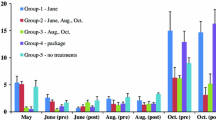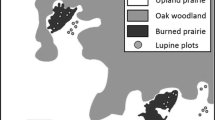Abstract
Aphids can cause major environmental problems in urban areas. One important problem is the annual outbreaks of lime aphid, Eucallipterus tiliae (L.) (Hemiptera: Aphididae), which spoil the surroundings of lime trees by depositing honeydew. To date no environmentally friendly method has been demonstrated to yield effective control of lime aphids. Attempts are made in some cities to control lime aphids by releasing larvae of the native two-spot ladybird beetle, Adalia bipunctata (L.) (Coleoptera: Coccinellidae). However, it is known that adult ladybird beetles disperse soon after release, and there is little indication they provide control of the aphids. Here, we demonstrate experimentally that releases of a flightless strain of A. bipunctata, obtained from natural variation in wing length, can reduce the impact of honeydew from lime aphid outbreaks on two species of lime in an urban environment. Both larvae and adult beetles were released, and we discuss the contribution of the flightless adults to the decline in honeydew.


Similar content being viewed by others
References
Adachi-Hagimori T, Shibao M, Tanaka H, Seko T, Miura K (2011) Control of Myzus persicae and Lipaphis erysimi (Hemiptera: aphididae) by adults and larvae of a flightless strain of Harmonia axyridis (Coleoptera: Coccinellidae) on non-heading Brassica cultivars in the greenhouse. BioControl 56:207–213
Blackman RL, Eastop VF (1994) Aphids on the world’s trees. An identification and information guide. CAB International, Wallingford, UK
Brakefield PM (1984) Ecological studies on the polymorphic ladybird Adalia bipunctata in The Netherlands. 2. Population dynamics, differential timing of reproduction and thermal melanism. J Anim Ecol 53:775–790
Carter CI, Nichols JFA (1986) The lime aphid, Eucallipterus tiliae. In: Juniper BE, Southwood TRE (eds) Insects and the plant surface. Edward Arnold, London, UK, p 342
Dahlsten DL, Zuparko RL, Hajek AE, Rowney DL, Dreistadt SH (1999) Long-term sampling of Eucallipterus tiliae (Homoptera: Drepanosiphidae) and associated natural enemies in a northern California site. Environ Entomol 28:845–850
Day KR, Docherty M, Leather SR, Kidd NAC (2006) The role of generalist insect predators and pathogens in suppressing green spruce aphid populations through direct mortality and mediation of aphid dropping behavior. Biol Control 38:233–246
De Clercq P, Bonte M, van Speybroeck K, Bolckmans K, Deforce K (2005) Development and reproduction of Adalia bipunctata (Coleoptera: Coccinellidae) on eggs of Ephestia kuehniella (Lepidoptera: Phycitidae) and pollen. Pest Manag Sci 61:1129–1132
Dixon AFG (1971a) Role of aphids in wood formation. 1. Effect of sycamore aphid, Drepanosiphum platanoides (Schr) (Aphididae), on growth of sycamore, Acer pseudoplatanus (L). J Appl Ecol 8:165–179
Dixon AFG (1971b) Role of aphids in wood formation. 2. Effect of lime aphid, Eucallipterus tiliae L. (Aphididae), on growth of lime, Tilia x vulgaris Hayne. J Appl Ecol 8:393–399
Dixon AFG (1971c) Role of intra-specific mechanisms and predation in regulating numbers of lime aphid, Eucallipterus tiliae L. Oecologia 8:179–193
Dixon AFG (2000) Insect predator-prey dynamics. Ladybird beetles and biological control. Cambridge University Press, Cambridge, UK
Dixon AFG, Agarwala BK (1999) Ladybird-induced life-history changes in aphids. Proc R Soc Lond B 266:1549–1553
Dixon AFG, Barlow ND (1979) Population regulation in the lime aphid. Zool J Linn Soc Lond 67:225–237
Dreistadt SH, Dahlsten DL (1988) Tuliptree aphid honeydew management. J Arboric 14:209–214
Ferran A, Niknam H, Kabiri F, Picart JL, DeHerce C, Brun J, Iperti G, Lapchin L (1996) The use of Harmonia axyridis larvae (Coleoptera: Coccinellidae) against Macrosiphum rosae (Hemiptera: Sternorrhyncha: Aphididae) on rose bushes. Eur J Entomol 93:59–67
Ferran A, Giuge L, Tourniaire R, Gambier J, Fournier D (1998) An artificial non-flying mutation to improve the efficiency of the ladybird Harmonia axyridis in biological control of aphids. BioControl 43:53–64
Glen DM, Barlow ND (1980) Interaction of a population of the black-kneed capsid, Blepharidopterus angulatus, and its prey, the lime aphid. Ecol Entomol 5:335–344
Heimbach U (1982) Zur honigtauproduktion von zwei Callaphididen an Linde und Eiche. Apidologie 13:331–332
Ignoffo CM, Garcia C, Dickerson WA, Schmidt GT, Biever KD (1977) Imprisonment of entomophages to increase effectiveness––evaluation of a concept. J Econ Entomol 70:292–294
Iguchi M, Fukushima F, Miura K (2012) Control of Aphis gossypii and Myzus persicae (Hemiptera: Aphididae) by a flightless strain of Harmonia axyridis (Coleoptera: Coccinellidae) on green pepper plants in open fields. Entomol Sci 15:127–132
Jetter K, Paine TD (2004) Consumer preferences and willingness to pay for biological control in the urban landscape. Biol Control 30:312–322
Kalushkov P (1998) Ten aphid species (Sternorrhyncha: Aphididae) as prey for Adalia bipunctata (Coleoptera: Coccinellidae). Eur J Entomol 95:343–349
Kehrli P, Wyss E (2001) Effects of augmentative releases of the coccinellid, Adalia bipunctata, and of insecticide treatments in autumn on the spring population of aphids of the genus Dysaphis in apple orchards. Entomol Exp Appl 99:245–252
Kieckhefer RW, Olson GA (1974) Dispersal of marked adult Coccinellids from crops in South-Dakota. J Econ Entomol 67:52–54
Kindlmann P, Ameixa O, Dixon AFG (2011) Ecological effects of invasive alien species on native communities, with particular emphasis on the interactions between aphids and ladybirds. BioControl 56:469–476
Kuroda T, Miura K (2003) Comparison of the effectiveness of two methods for releasing Harmonia axyridis (Pallas) (Coleoptera: Coccinellidae) against Aphis gossypii Glover (Homoptera: Aphididae) on cucumbers in a greenhouse. Appl Entomol Zool 38:271–274
Lommen STE, De Jong PW, Brakefield PM (2005) Phenotypic plasticity of elytron length in wingless two-spot ladybird beetles, Adalia bipunctata (Coleoptera: Coceinellidae). Eur J Entomol 102:553–556
Lommen STE, Middendorp CW, Luijten CA, van Schelt J, Brakefield PM, de Jong PW (2008) Natural flightless morphs of the ladybird beetle Adalia bipunctata improve biological control of aphids on single plants. Biol Control 47:340–346
Lommen STE, Saenko SV, Tomoyasu Y, Brakefield PM (2009) Development of a wingless morph in the ladybird beetle, Adalia bipunctata. Evol Dev 11:278–289
Losey JE, Denno RF (1998) The escape response of pea aphids to foliar-foraging predators: factors affecting dropping behaviour. Ecol Entomol 23:53–61
Majerus MEN, Kearns PWE (1989) Ladybirds. Richmond Publishing Company, Slough, UK
Mann JA, Tatchell GM, Dupuch MJ, Harrington R, Clark SJ, McCartney HA (1995) Movement of apterous Sitobion avenae (Homoptera, Aphididae) in response to leaf disturbances caused by wind and rain. Ann Appl Biol 126:417–427
Marples NM, De Jong PW, Ottenheim MM, Verhoog MD, Brakefield PM (1993) The inheritance of a wingless character in the 2spot ladybird (Adalia bipunctata). Entomol Exp Appl 69:69–73
Mawson CA (1948) Honeydew on lime trees. Nature 161:176
Minks AK, Harrewijn P (1987) Aphids, their biology, natural enemies and control. Elsevier, Amsterdam, The Netherlands
Obrycki JJ, Kring TJ (1998) Predaceous Coccinellidae in biological control. Annu Rev Entomol 43:295–321
Obrycki JJ, Harwood JD, Kring TJ, O’Neil RJ (2009) Aphidophagy by Coccinellidae: application of biological control in agroecosystems. Biol Control 51:244–254
Ohde T, Masumoto M, Morita-Miwa M, Matsuura H, Yoshioka H, Yaginuma T, Niimi T (2009) Vestigial and scalloped in the ladybird beetle: a conserved function in wing development and a novel function in pupal ecdysis. Insect Mol Biol 18:571–581
Powell W, Pell JK (2007) Biological control. In: van Emden HF, Harrington R (eds) Aphids as crop pests. CAB International, Wallingford, UK, pp 469–513
R Development Core Team (2007) R: a language and environment for statistical computing. R Foundation for Statistical Computing, Vienna, Austria
Seko T, Yamashita K, Miura K (2008) Residence period of a flightless strain of the ladybird beetle Harmonia axyridis Pallas (Coleoptera: Coccinellidae) in open fields. Biol Control 47:194–198
Tourniaire R, Ferran A, Gambier J, Giuge L, Bouffault F (1999) Locomotor behavior of flightless Harmonia axyridis Pallas (Col., Coccinellidae). J Insect Behav 12:545–558
Trouvé C, Ledee S, Ferran A, Brun J (1997) Biological control of the damson-hop aphid, Phorodon humuli (Hom.: Aphididae), using the ladybeetle Harmonia axyridis (Col.: Coccinellidae). Entomophaga 42:57–62
Ueno H, de Jong PW, Brakefield PM (2004) Genetic basis and fitness consequences of winglessness in the two-spot ladybird beetle, Adalia bipunctata. Heredity 93:283–289
van Lenteren JC, Loomans AJM, Babendreier D, Bigler F (2008) Harmonia axyridis: an environmental risk assessment for Northwest Europe. BioControl 53:37–54
Weisser WW, Braendle C, Minoretti N (1999) Predator-induced morphological shift in the pea aphid. Proc R Soc Lond B 266:1175–1181
Wratten SD (1973) Effectiveness of coccinellid beetle, Adalia bipunctata (L.), as a predator of lime aphid, Eucallipterus tiliae L. J Anim Ecol 42:785–802
Wratten SD (1976) Searching by Adalia bipunctata L. (Coleoptera-Coccinellidae) and escape behavior of its aphid and cicadellid prey on lime (Tilia x vulgaris Hayne). Ecol Entomol 1:139–142
Wyss E, Villiger M, Hemptinne JL, Muller-Scharer H (1999) Effects of augmentative releases of eggs and larvae of the ladybird beetle, Adalia bipunctata, on the abundance of the rosy apple aphid, Dysaphis plantaginea, in organic apple orchards. Entomol Exp Appl 90:167–173
Zuparko RL, Dahlsten DL (1994) Host plant resistance and biological control for linden aphids. J Arboric 20:278–281
Zuparko RL, Dahlsten DL (1995) Parasitoid complex of Eucallipterus tiliae (Homoptera, Drepanosiphidae) in Northern California. Environ Entomol 24:730–737
Zuparko RL, Dahlsten DL (1996) New potential for classical biological control of Eucallipterus tiliae (Homoptera: Drepanosiphidae). Biol Control 6:407–408
Acknowledgments
We are grateful to the Slotervaart district and Hans Kaljee from the community of Amsterdam, The Netherlands for the use of the lime trees, and we especially thank Sandro Hooft for support during the experiment. We thank Kees Koops and Martijn Guliker for help in rearing ladybirds, and Koppert B.V. for Ephestia eggs. We thank Miriam Visser and Henry Kuppen for sharing experiences in lime aphid suppression, Bas Zwaan for discussion about the results, and two anonymous reviewers for their constructive comments. This research was supported by the Technology Foundation STW, applied science division of NWO and the technology program of the Dutch Ministry of Economic Affairs, and by Applied Plant Research Wageningen University and Research Centre, Lisse.
Author information
Authors and Affiliations
Corresponding author
Additional information
Handling Editor: Patrick De Clercq
Rights and permissions
About this article
Cite this article
Lommen, S.T.E., Holness, T.C., van Kuik, A.J. et al. Releases of a natural flightless strain of the ladybird beetle Adalia bipunctata reduce aphid-born honeydew beneath urban lime trees. BioControl 58, 195–204 (2013). https://doi.org/10.1007/s10526-012-9478-7
Received:
Accepted:
Published:
Issue Date:
DOI: https://doi.org/10.1007/s10526-012-9478-7




